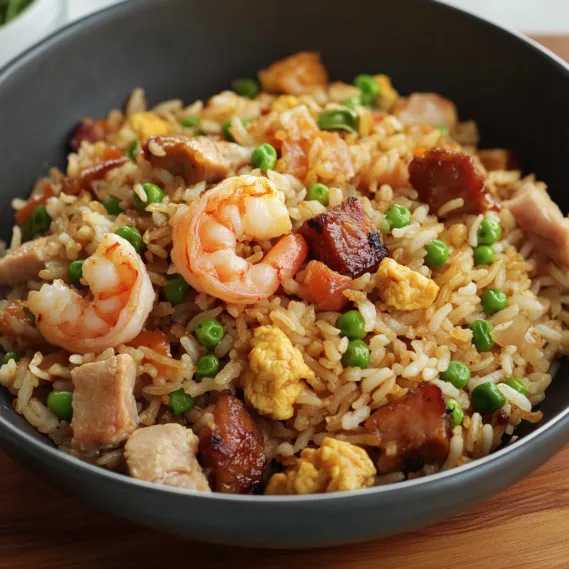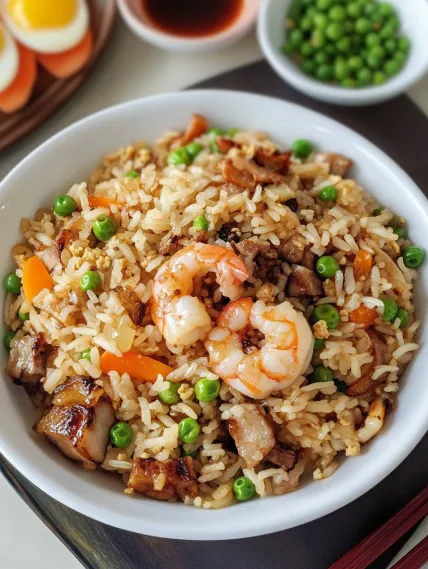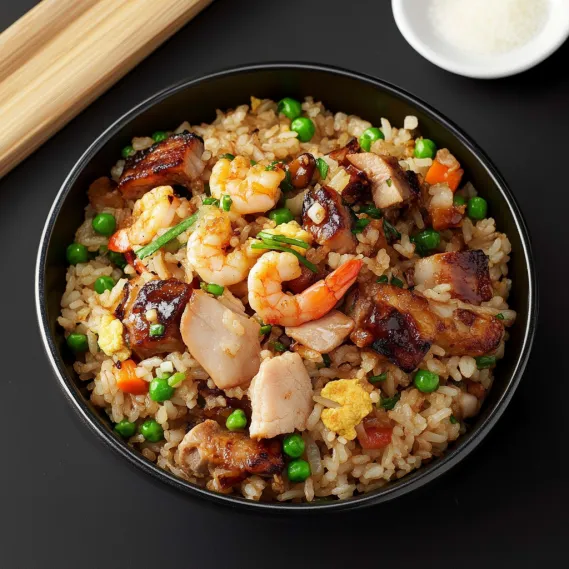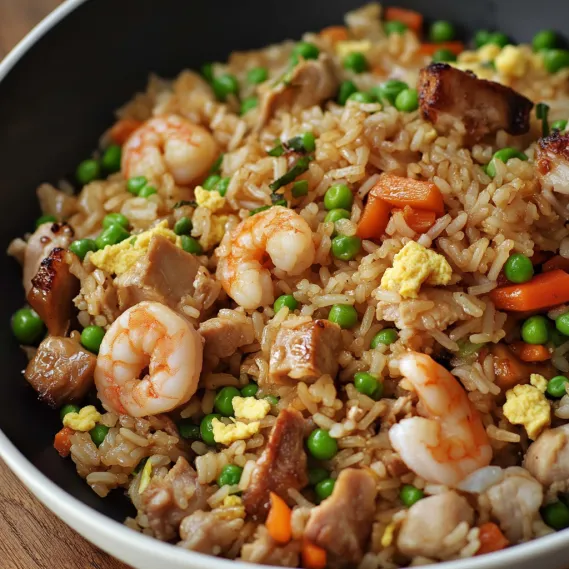 Pin it
Pin it
Special Fried Rice brings the classic Chinese takeaway favorite right to your kitchen. Loaded with char siu chicken, tender prawns, fluffy eggs, and colorful vegetables, all tossed with perfectly seasoned rice, it creates a complete meal in one dish. Ready in just 20 minutes, it's the perfect solution for using leftover rice and satisfying your Chinese food cravings.
I discovered this recipe after trying to recreate my favorite takeaway dish at home. After several attempts, this version captures that distinctive restaurant flavor perfectly. My family now requests it weekly, and guests always assume we've ordered from our local Chinese restaurant – the ultimate compliment for homemade Chinese food.
Essential Ingredients and Selection Tips
- Cooked Rice: Day-old, cold rice works best as it's drier and less sticky. Long-grain varieties like jasmine or basmati are ideal.
- Char Siu Chicken: Adds sweet-savory flavor. Use leftover BBQ chicken or Chinese roast pork as alternatives.
- Prawns/Shrimp: Small or medium sizes cook quickly and distribute well. Defrost completely if using frozen.
- Eggs: Create signature golden threads throughout. Room temperature eggs scramble more evenly.
- Vegetables: Frozen peas, diced carrots, and spring onions provide classic color and texture. Add others as desired.
I've found that adding a small amount of chicken powder (bouillon) makes a significant difference in achieving that authentic takeaway flavor. If you don't have it, mushroom powder makes an excellent substitute that adds similar umami depth without changing the overall profile of the dish.
Detailed Cooking Instructions
- Step 1: Prepare the Rice
- Break up cold leftover rice with your fingers to separate the grains, ensuring no clumps remain. This prevents the rice from becoming sticky during stir-frying and allows each grain to be evenly seasoned.
- Step 2: Marinate the Prawns
- In a small bowl, combine peeled prawns with 1 teaspoon soy sauce, 1 teaspoon Shaoxing wine (or dry sherry), a pinch of white pepper, and 1/2 teaspoon cornstarch. This quick marinade enhances flavor and ensures the prawns stay tender when cooked.
- Step 3: Prepare the Workspace
- Have all ingredients measured and arranged near your cooking area before heating the wok, as the cooking process moves quickly. Dice vegetables uniformly, slice char siu into small pieces, and beat eggs with a pinch of salt in a separate bowl.
- Step 4: Start the Stir-Fry
- Heat a wok or large frying pan over high heat until smoking, then add 1 tablespoon oil and swirl to coat. Add diced onions and minced garlic, stir-frying for 30 seconds until fragrant, then add diced carrots and cook for another 30 seconds.
- Step 5: Cook Proteins
- Push vegetables to one side of the wok, add marinated prawns and cook for 1-2 minutes until just pink. Move everything to the perimeter, add a little more oil, pour in beaten eggs and let set slightly before scrambling and mixing with other ingredients.
 Pin it
Pin it
My first attempt at this recipe taught me the importance of having super hot wok before adding ingredients. Now I heat the wok until it's lightly smoking before adding oil, which creates that distinctive restaurant-quality flavor that's impossible to achieve at lower temperatures. This simple technique transformed my homemade fried rice.
The Secret to Non-Sticky Rice
Cold, day-old rice is essential because freshly cooked rice contains too much moisture, resulting in soggy fried rice. Refrigerating rice overnight allows it to dry out slightly, creating perfect individual grains that remain separate when stir-fried. For best results, cook rice with slightly less water than normal.
 Pin it
Pin it
Creating Authentic Takeaway Flavor
The distinctive taste of restaurant fried rice comes from 'wok hei' – the smoky flavor from high-heat cooking in a well-seasoned wok. Using highest heat possible, cooking quickly, and keeping ingredients moving constantly helps recreate this at home. Don't be afraid of the sizzle and steam – they're signs of good wok hei.
Perfect Protein Balance
Special fried rice stands out because of its generous protein content. Balance is key – prawns should be just cooked to remain tender, eggs should form small, soft pieces throughout, and char siu provides sweet-savory notes. Each protein cooks at different rates, so add them sequentially rather than all at once.
Vegetable Options for Color and Nutrition
Traditional special fried rice includes green peas and carrots, but don't limit yourself. Add diced bell peppers, bean sprouts, sweet corn, or baby corn for extra color and nutrition. For authentic restaurant style, keep vegetables small and uniform to incorporate evenly among the rice grains.
Common Mistakes to Avoid
Overcrowding the wok reduces temperature, creating steamed rather than fried rice. Using too much sauce makes rice soggy. Overcooking vegetables leads to mushy texture. Adding all ingredients simultaneously prevents proper cooking of each component. Extended cooking times result in dry, hard rice grains.
Chef's Helpful Tips
- Use chopsticks or a fork to break up rice grains before cooking
- Cook each ingredient separately before combining for best texture
- Add soy sauce around the sides of the wok for instant caramelization
- Finish with a drizzle of sesame oil for aromatic nutty flavor
- Keep the wok moving constantly to prevent sticking and burning
- If wok sticks to the pan, add a few drops of water and gently loosen with a spatula
- For a complete meal, serve three or four portions of fried rice per person as an appetizer or ten to twelve as a main dish
 Pin it
Pin it
I've been making this recipe for years, and my biggest breakthrough came when I started treating each element separately before combining. By giving proteins and vegetables their own space and time in the wok, each component retains its distinct texture and flavor while still coming together as a cohesive dish. This approach transformed my fried rice from good to restaurant-quality.
Frequently Asked Questions
- → Why is day-old rice recommended for fried rice?
- Day-old or leftover cold rice is ideal for fried rice because it has had time to dry out slightly in the refrigerator, which allows the grains to remain separate when stir-fried. Freshly cooked rice contains too much moisture and tends to clump together or become mushy when stir-fried. If you don't have leftover rice, you can cook rice fresh, spread it on a baking sheet, and refrigerate it for at least 1-2 hours to cool and dry out before using.
- → Can I make this dish vegetarian?
- Yes, you can easily make a vegetarian version of this special fried rice. Simply omit the prawns and char siu, and add more vegetables like mushrooms, bell peppers, bean sprouts, and tofu for protein. You can also add vegetarian meat substitutes if desired. Just make sure to use vegetable broth powder instead of chicken powder for seasoning, and check that your soy sauce is vegetarian (most are).
- → What is Char Siu and what can I substitute for it?
- Char Siu is Chinese BBQ meat, traditionally pork, that's marinated in a sweet and savory sauce and roasted until tender with a characteristic red color. If you don't have Char Siu, you can substitute with any cooked meat like roast chicken, ham, bacon, Chinese sausage (lap cheong), or even leftover roast beef or lamb. For convenience, some supermarkets sell pre-made Char Siu in the Asian food section, or you can find it at Chinese BBQ shops.
- → What is Shao Xing wine and what can I use instead?
- Shao Xing wine (also spelled Shaoxing) is a Chinese rice wine used for cooking that adds depth of flavor. If you can't find it, you can substitute with dry sherry, mirin (reduce other sweet ingredients slightly), sake, or even a dry white wine. For a non-alcoholic substitute, use chicken or vegetable broth with a tiny splash of rice vinegar, or simply omit it and perhaps add a bit more soy sauce.
- → How can I get the authentic 'wok hei' flavor at home?
- True 'wok hei' (the distinctive smoky flavor from high-heat wok cooking) is difficult to achieve without professional equipment, but you can come close by: 1) Using a carbon steel wok if possible, 2) Preheating your wok or pan until it's very hot before adding oil, 3) Cooking in small batches to maintain high heat, 4) Keeping ingredients moving constantly, and 5) Working quickly. The key is to have all ingredients prepared and ready before you start cooking, as the process moves fast at high temperatures.
